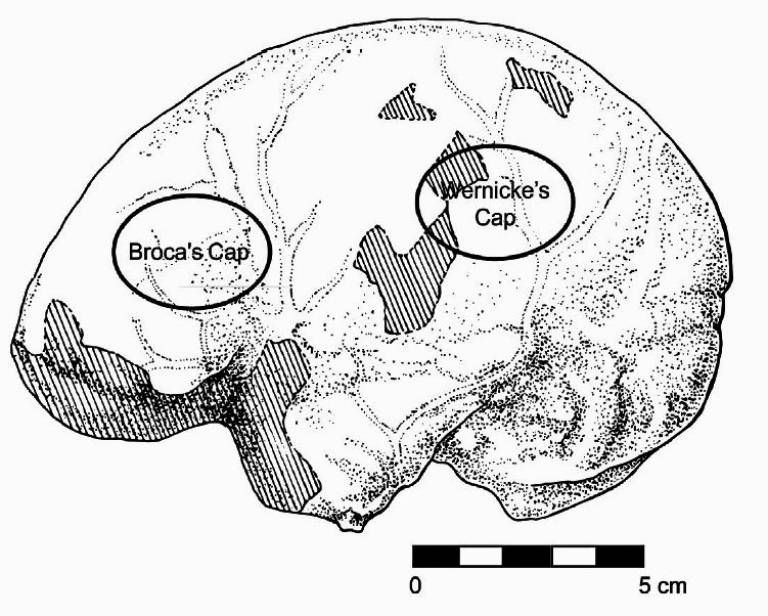Publication in Journal of Neurolinguistics claims that 'Full-fledged language appeared 40,000 to 50,000 years ago'
7 March 2017
Publication Abstract: The fossil indications for speech, inferred from skull endocasts and from the anatomy of the vocal tract, the vertebral column, and the bony ear, suggest that there was a grade shift from the australopiths (Australopithecus and Paranthropus), who lived mainly before two Ma (million years ago), to species of Homo, who lived mainly afterwards.
 The australopiths were probably no more capable of speech than living chimpanzees are, but bones suggest that all fossil species of Homo anticipated living humans in their speech ability. The oldest well-documented stone tools, assigned to the Oldowan Tradition between 2.6 and 1.76 Ma, required a sophisticated understanding of how to produce sharp-edged flakes routinely. Verbal instruction, albeit at a rudimentary level, was probably required to transmit this understanding between individuals and from generation to generation. More complex, though still primitive forms of language were likely linked to post-Oldowan technological advances, including the appearance of the Acheulean Tradition, defined by hand axes and other shaped stone tools 1.76 Ma, the addition of more refined hand axes to the Acheulean Tradition 1-0.7 Ma, and finally the abandonment of hand axes in favor of a wide variety of flake tools, probably often mounted on wooden handles, in the African Middle Stone Age and west Eurasian Middle Paleolithic beginning 300-250 ka (thousands of years ago). Putative art objects and personal ornaments that occasionally occur in African Middle Stone Age sites between 100 and 60 ka may imply "symbolism", intimately connected to language historically, but if the limited archaeological evidence is accepted, it implies a form of symbolism that was qualitatively different from the unambiguous historical variety. The historical kind, marked by indisputable art and personal ornaments, appeared only 50-40 ka, which suggests this was also when full-fledged language appeared. The abrupt appearance of language and other fully modern cognitive traits 50-40 ka surely occurred in Africa, and enhanced cognition is likely to explain the nearly simultaneous expansion of fully modern Africans to Eurasia, where they replaced or swamped the Neanderthals and other non-modern humans. Ancient DNA could be used to test the idea that fully featured language appeared about 50 ka, if it becomes possible to determine whether the Neanderthals and other non-modern humans lacked some genes that underpin language and other cognitive functions in all living people.
The australopiths were probably no more capable of speech than living chimpanzees are, but bones suggest that all fossil species of Homo anticipated living humans in their speech ability. The oldest well-documented stone tools, assigned to the Oldowan Tradition between 2.6 and 1.76 Ma, required a sophisticated understanding of how to produce sharp-edged flakes routinely. Verbal instruction, albeit at a rudimentary level, was probably required to transmit this understanding between individuals and from generation to generation. More complex, though still primitive forms of language were likely linked to post-Oldowan technological advances, including the appearance of the Acheulean Tradition, defined by hand axes and other shaped stone tools 1.76 Ma, the addition of more refined hand axes to the Acheulean Tradition 1-0.7 Ma, and finally the abandonment of hand axes in favor of a wide variety of flake tools, probably often mounted on wooden handles, in the African Middle Stone Age and west Eurasian Middle Paleolithic beginning 300-250 ka (thousands of years ago). Putative art objects and personal ornaments that occasionally occur in African Middle Stone Age sites between 100 and 60 ka may imply "symbolism", intimately connected to language historically, but if the limited archaeological evidence is accepted, it implies a form of symbolism that was qualitatively different from the unambiguous historical variety. The historical kind, marked by indisputable art and personal ornaments, appeared only 50-40 ka, which suggests this was also when full-fledged language appeared. The abrupt appearance of language and other fully modern cognitive traits 50-40 ka surely occurred in Africa, and enhanced cognition is likely to explain the nearly simultaneous expansion of fully modern Africans to Eurasia, where they replaced or swamped the Neanderthals and other non-modern humans. Ancient DNA could be used to test the idea that fully featured language appeared about 50 ka, if it becomes possible to determine whether the Neanderthals and other non-modern humans lacked some genes that underpin language and other cognitive functions in all living people.
Language and human evolution
Richard G. Klein
DOI: 10.1016/j.jneuroling.2016.11.004
 Close
Close

